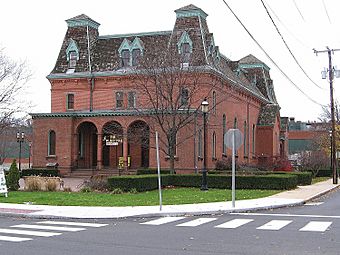Manchester Historic District (Manchester, Connecticut) facts for kids
Quick facts for kids |
|
|
Manchester Historic District
|
|

Cheney Hall
|
|
| Location | Roughly bounded by Center Spring Park, Main St., Interstate 384, and Campfield Rd., Manchester, Connecticut |
|---|---|
| Area | 500 acres (200 ha) |
| Architect | Charles Adams Platt; et.al. |
| Architectural style | Gothic Revival, Late Victorian, et.al. |
| NRHP reference No. | 00000857 |
| Added to NRHP | August 2, 2000 |
The Manchester Historic District is a special area in Manchester, Connecticut. It shows how a town grew around a big business. This district includes many old buildings, homes, and factories. It tells the story of the Cheney Brothers Historic District, famous for making silk. This important area was added to the National Register of Historic Places in 2000.
What is the Manchester Historic District?
The Manchester Historic District is a large area in Manchester, Connecticut. It covers about 500 acres. This district is west of the town's main street. It includes most of the Cheney Brothers Historic District. That area is a National Historic Landmark District. It has silk factories, worker homes, and houses where the Cheney family lived. The district also includes other neighborhoods. These areas grew because of the Cheney family's influence.
A Town Built on Silk
The town of Manchester was first settled in the 1600s. For a long time, it was mostly a farming area. But in 1838, the Cheney family started a silk business. This business became very important to the town. It shaped Manchester's economy for over 100 years.
The Cheneys basically built a "company town." This means they provided many things for their workers. They built homes, churches, and schools. They even created a water system. This system served both the factories and the town. The main factory buildings are west of Main Street. They are north of Interstate 384. These factories are the heart of the National Historic Landmark district. The large homes of the Cheney family are to the east. The company-owned worker housing is just north and west of the factories.
Homes and History in the District
The Manchester Historic District is bigger than the original landmark district. It stretches northward to Center Springs Park. This park was created from land given by the Cheneys. Another important family, the Hillards, also donated land.
Most of this expanded area has homes. These are mainly one- or two-family wooden houses. Many of them have simple, classic designs. Later additions to the district include apartment buildings. These were built in 1944 on St. James Street and Garden Drive. They helped meet the need for housing during World War II.



